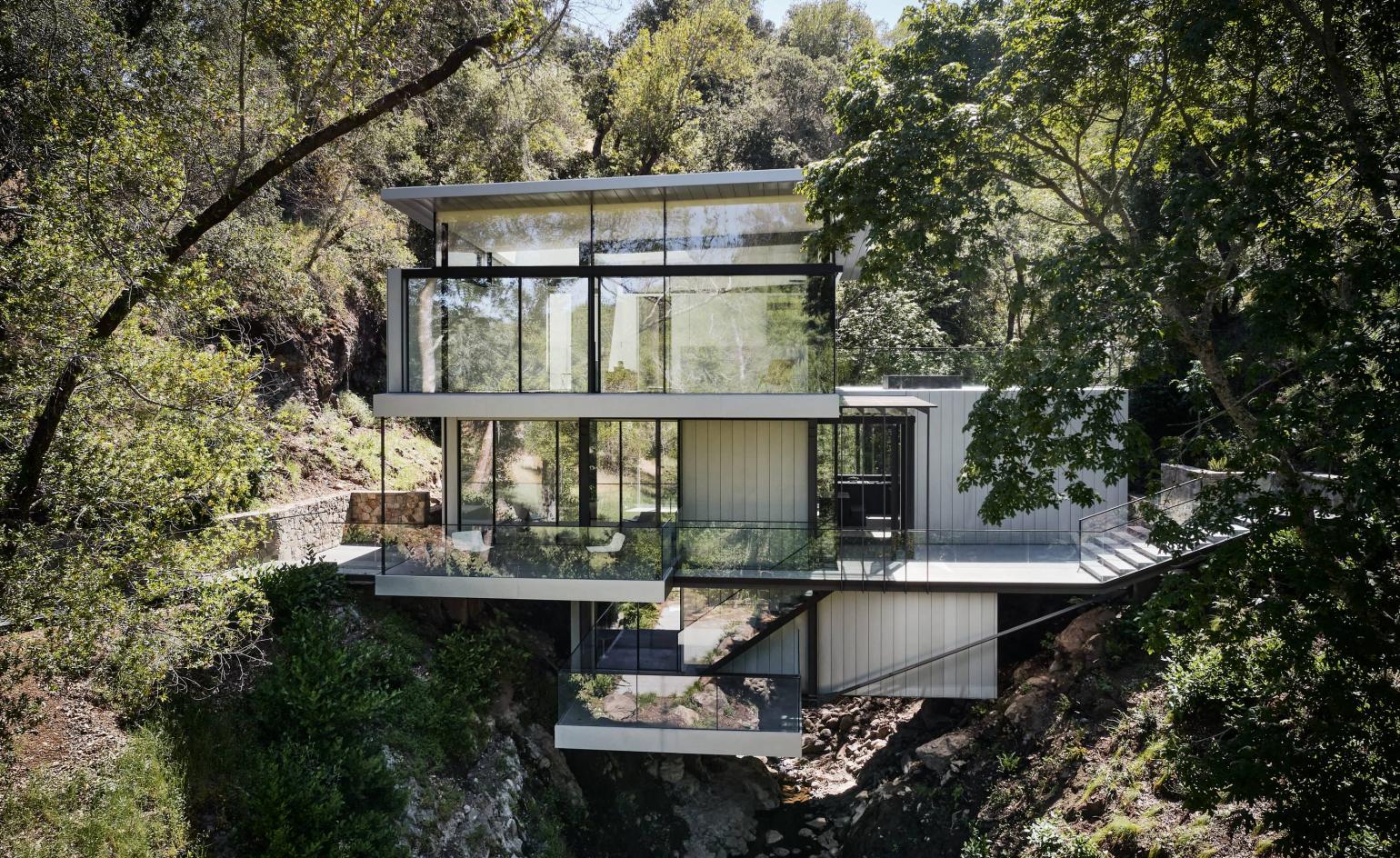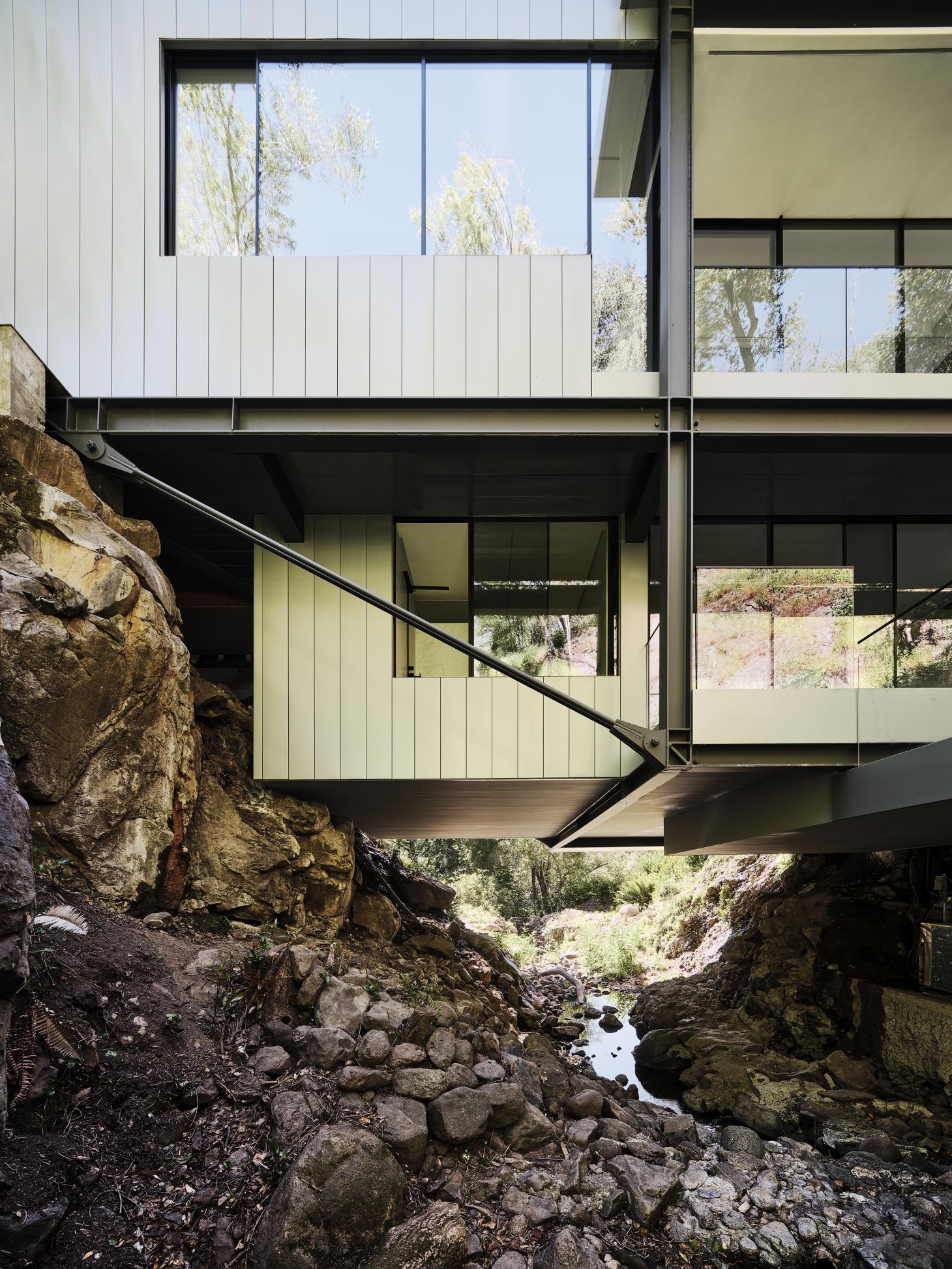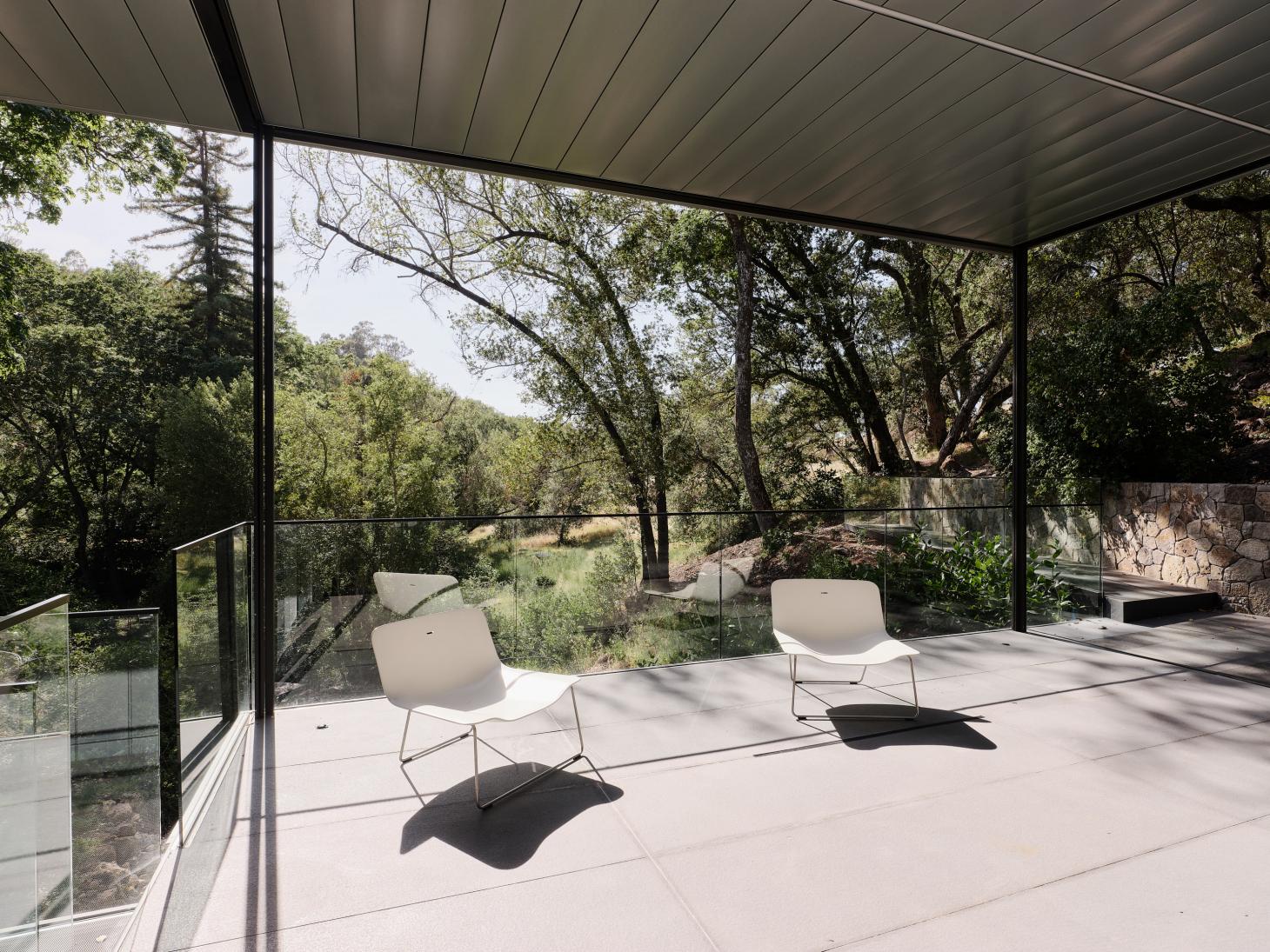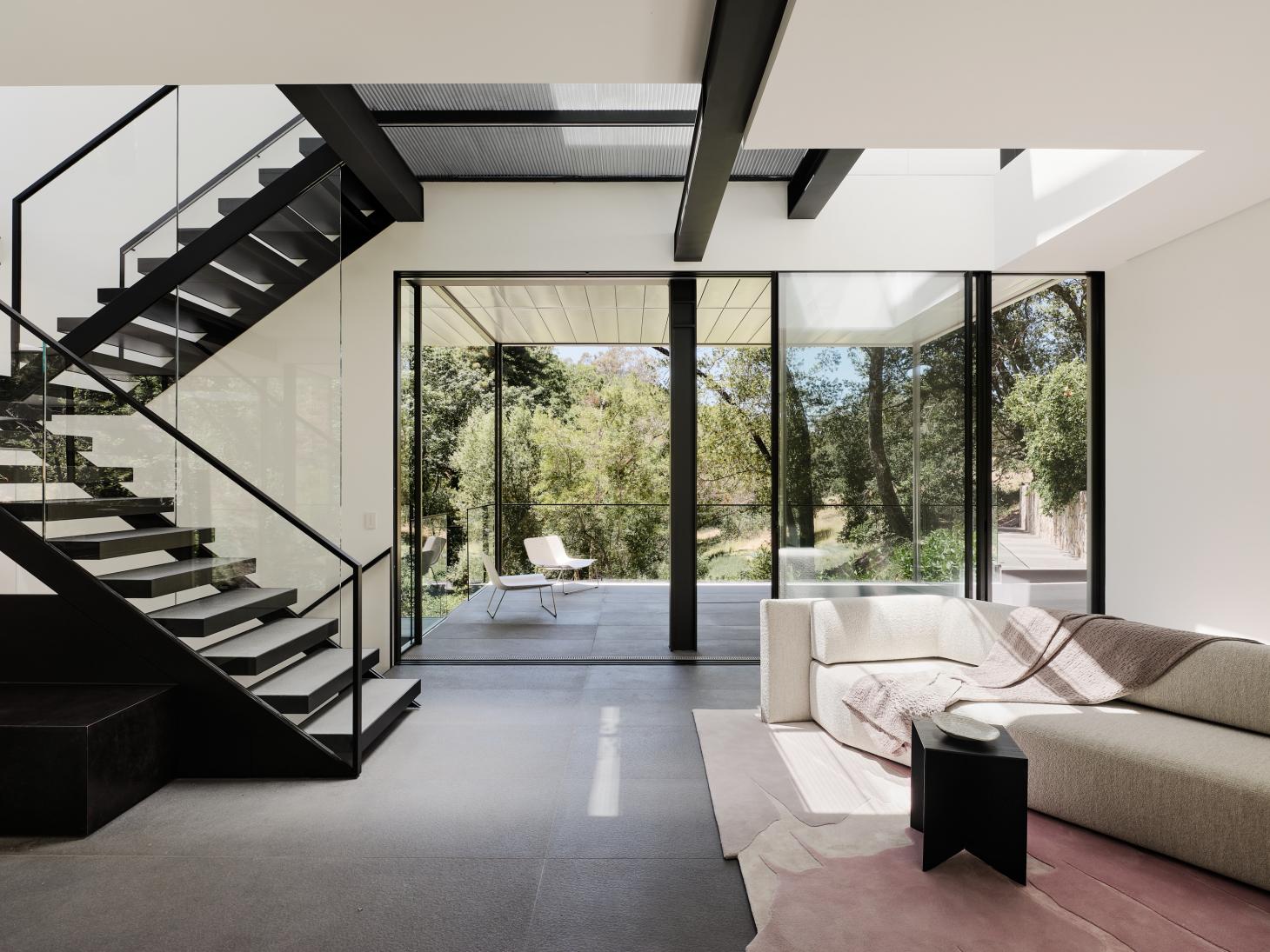Suspension House spans a creek in the Californian hills
Anne Fougeron has remodelled an existing house into a striking new Californian home that combines classic modernist aesthetics with a very contemporary respect for the landscape
Joe Fletcher - Photography

The Suspension House is one of those rare architectural statements that only comes along once in a generation. The combination of site, vision, and skill is so often squandered, but San Francisco-based architect Anne Fougeron has translated her clients’ desires into spectacular reality, respecting the wildness of the site without compromising on the clarity of the design.

The existing house occupies the kind of site that is not only rare but actually forbidden (California no longer allows homes to be built across a creek), so Fougeron and her team had to make the most of the opportunity. The original house had to be retrofitted with new structure to support the load of the new additions, all while touching only lightly on the ground.

‘A man-made object in nature may exist in harmony or disparity,’ Fougeron points out, ‘The goal was to reconnect this structure into the environment while best utilizing the exceptional site for the clients.’ The law dictated that the new structure had to follow the exact outline of the original house, which luckily included three generous outdoor areas.

A carefully planned structural system allowed the mass of the original house to be expanded with a new upper floor, rotated 90 degrees to the main structure. Whereas the first house was supported by columns that were driven into the creek bed, the architects and engineers came up with a suspension bridge-type structure slung between the two slopes. This allowed the water to run impeded beneath the house.

The proximity to water has been exploited at every conceivable occasion. With structural elements and fixtures like the staircase and kitchen finished in dark colours and floors, ceilings, and internal wall planes in white, the house is set up as a simple, unassuming frame to the wilderness beyond.

Transparent materials are used throughout, including floor-to-ceiling windows, glass doors and balustrades, and open tread staircases, ensuring that the verdant cliffs, surrounding forest and running water are felt from every room in the house.

The house is entered from the second floor via a walkway threaded through the forest, with an open plan living and dining space occupying the entire level. Decks at front and rear overlook the creek, which runs east-west beneath the house.
Receive our daily digest of inspiration, escapism and design stories from around the world direct to your inbox.

A guest suite with its own private deck is located on the bottom-most floor, along with utility areas, while the primary bedroom suite is set within the new third floor. Up here there’s another bedroom and flexible space, with a new roof terrace opening off the largest bedroom.

A separate guest house is located alongside the path to the main house, with black cladding to distinguish it, and a sleeping platform and galley kitchen.

Not many houses have a waterfall in their backyard - a certain Fallingwater by Frank Lloyd Wright springs to mind. Fougeron describes the project as a house that ‘balances the role of architecture - especially modernism - in nature with the role of the client to their home,’ and the end result certainly meets the challenge.
The architect set up her studio in 1985 and has won multiple awards. Previous projects include the Fall House in Big Sur and a collaboration with OMA on The Avery tower in San Francisco. §


INFORMATION
Jonathan Bell has written for Wallpaper* magazine since 1999, covering everything from architecture and transport design to books, tech and graphic design. He is now the magazine’s Transport and Technology Editor. Jonathan has written and edited 15 books, including Concept Car Design, 21st Century House, and The New Modern House. He is also the host of Wallpaper’s first podcast.
-
 Year in review: the shape of mobility to come in our list of the top 10 concept cars of 2025
Year in review: the shape of mobility to come in our list of the top 10 concept cars of 2025Concept cars remain hugely popular ways to stoke interest in innovation and future forms. Here are our ten best conceptual visions from 2025
-
 These Guadalajara architects mix modernism with traditional local materials and craft
These Guadalajara architects mix modernism with traditional local materials and craftGuadalajara architects Laura Barba and Luis Aurelio of Barbapiña Arquitectos design drawing on the past to imagine the future
-
 Robert Therrien's largest-ever museum show in Los Angeles is enduringly appealing
Robert Therrien's largest-ever museum show in Los Angeles is enduringly appealing'This is a Story' at The Broad unites 120 of Robert Therrien's sculptures, paintings and works on paper
-
 Step inside this resilient, river-facing cabin for a life with ‘less stuff’
Step inside this resilient, river-facing cabin for a life with ‘less stuff’A tough little cabin designed by architects Wittman Estes, with a big view of the Pacific Northwest's Wenatchee River, is the perfect cosy retreat
-
 Remembering Robert A.M. Stern, an architect who discovered possibility in the past
Remembering Robert A.M. Stern, an architect who discovered possibility in the pastIt's easy to dismiss the late architect as a traditionalist. But Stern was, in fact, a design rebel whose buildings were as distinctly grand and buttoned-up as his chalk-striped suits
-
 Own an early John Lautner, perched in LA’s Echo Park hills
Own an early John Lautner, perched in LA’s Echo Park hillsThe restored and updated Jules Salkin Residence by John Lautner is a unique piece of Californian design heritage, an early private house by the Frank Lloyd Wright acolyte that points to his future iconic status
-
 The Stahl House – an icon of mid-century modernism – is for sale in Los Angeles
The Stahl House – an icon of mid-century modernism – is for sale in Los AngelesAfter 65 years in the hands of the same family, the home, also known as Case Study House #22, has been listed for $25 million
-
 Houston's Ismaili Centre is the most dazzling new building in America. Here's a look inside
Houston's Ismaili Centre is the most dazzling new building in America. Here's a look insideLondon-based architect Farshid Moussavi designed a new building open to all – and in the process, has created a gleaming new monument
-
 Frank Lloyd Wright’s Fountainhead will be opened to the public for the first time
Frank Lloyd Wright’s Fountainhead will be opened to the public for the first timeThe home, a defining example of the architect’s vision for American design, has been acquired by the Mississippi Museum of Art, which will open it to the public, giving visitors the chance to experience Frank Lloyd Wright’s genius firsthand
-
 Clad in terracotta, these new Williamsburg homes blend loft living and an organic feel
Clad in terracotta, these new Williamsburg homes blend loft living and an organic feelThe Williamsburg homes inside 103 Grand Street, designed by Brooklyn-based architects Of Possible, bring together elegant interiors and dramatic outdoor space in a slick, stacked volume
-
 This ethereal Miami residence sprouted out of a wild, jungle-like garden
This ethereal Miami residence sprouted out of a wild, jungle-like gardenA Miami couple tapped local firm Brillhart Architecture to design them a house that merged Florida vernacular, Paul Rudolph and 'too many plants to count’